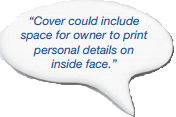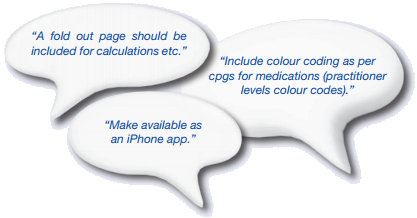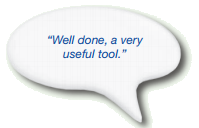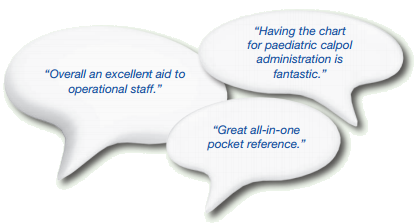
FORMAT
- Better quality ring binder.
- More durable, particularly the outer covers.
- Material of pages should be more durable and waterproofed
- Include additional blank pages at rear for individual notes/numbers
- Better colour code tabs.Page tabs could be one letter per tab or show all the letters on each tab i.e. A-B-C.
Tabs are a good idea but should include index of the topic they cover.
- Use other colours besides blue, could be more like the CPGs.
- If the layout of the handbook had a clip where additional sheets could be added.
- Should be constructed to open from right to left like a conventional book.
- Tabs just folded after one shift.
- Can’t find info easily in contents and tabs very poor.
- Size should be made small enough to fit into the uniform shirt pocket.

CLINICAL / CONTENT
- Quick-guide content list on the cover.
- I think that having a field guide with only the relevant info for the level each person practises at would be better, as searching through info that is not applicable is time consuming, e.g. all the drug are listed but only a few are relevant to my level.
- I would like the full medication calculations listed.
- Would suggest inclusion of a section on common medical abbreviations, to include common prescription terms and a spell checker list. Should also include the new Medical Oversight contact numbers.
- Insert a ruler on the edge of the outer cover giving coloured scale bands min and max widths of pr interval, qrs width and qt duration etc. a rate ruler for measuring rr intervals and for assessing regularity of rhythms also.
- I think there should be more content surrounding the most common medical and traumatic situations faced from day-to-day including childbirth as it is not a common call so info ready to hand would be a good resource.
|
|
- Consider putting in an anatomical diagram indicating different regions of the body. A dermatone map would also be useful.
- An age per page section might be useful.
- Like to see paedi weight calculations etc.
- Maybe put in ambulance control centre call numbers with hospital numbers.
- I think the Wong Baker faces need to be in a line of order left to right as on the pain scale.
- Could the blank pages have the actual CPG printed to coincide with the medication as a reminder?
- An ASHICE report with a brief explanation of each letter is very necessary, the standard of verbal handovers in the NAS aren’t very standard at present.
- From the EMT point of view, it would be helpful if the medications section had a reference to EMT usage, especially where they differ from P/AP, e.g. salbutamol.
- Separate the guide into named relevant sections; Neuro; Cardiac; etc
- There should be a little more on ECG interpretation maybe a reminder of what the basic rhythms look like.
- Is there any chance that they could lay out ONE page that just reminds us of the med doses for adult and paediatric (for paramedics) i.e. for the most common medications given e.g. Aspirin, Epinephrine, Glucagon, Glucose Gel, GTN, and the new meds coming on stream.
 GENERAL GENERAL
- Very well laid out.
- Great tool for all responders.
- Very good aid, looking forward to next version.
- Great to have pocket size reference.
- A good field guide...well done .... would be willing to pay up to €10 with improvements.
- This booklet is very useful in the field for rapid decision making without time delay. An excellent aid for pre-hospital care for practitioners. Well done PHECC.
- Absolutely excellent field guide, small and easy to become part of your daily kit but very comprehensive and informative particularly with all the drug dosages laid out so well and is fantastic for paeds dosages.
- Mostly practical and well put together; have used it on several occasions now.
- Perhaps copies could be put into vehicle drugs bag and included in vehicle daily check sheet. As this field guide is very important in facilitating safe practise.
- Well done gang. Another step in the right direction. Cheers.
- This is a great advancement in our field. The book is easy to use, compact and well written. A fantastic attachment for an AP, credit to all the team at PHECC. Great progress as ever from PHECC.
- Fantastic booklet, almost all the essential information from the cpg’s that you need on the road. Medication doses an excellent benefit. Well done.
- Probably one of the best ideas to come out of PHECC, something tangible, a real improvement that we can see and use for our benefit.
- As one of the APs said its now part of your uniform! The book itself is a great resource and always readily available on the person, well laid out and brilliant design.

|